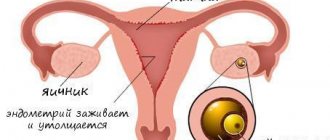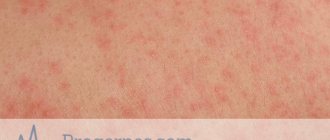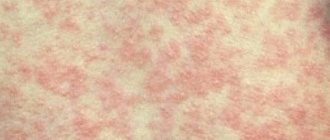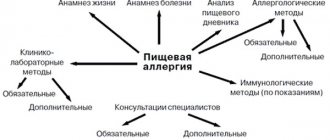Meningitis
Meningitis is a disease that affects the membranes of the membranes of the brain and spinal cord, while the cells of the organ itself are not damaged. The pathological process occurs outside the meninges. There are two types of this disease, bacterial and viral.
Most often, meningitis is viral in nature, occurring due to advanced and untreated viral infections. Bacterial types of this disease are much less common, but damage the brain more seriously and its consequences are more severe.
Almost every year, outbreaks of viral meningitis occur in certain areas, affecting in most cases children and young people, but in this case the disease cannot be called fatal, since with timely and adequate treatment it recedes.
You can get meningitis for various reasons, but there are risk factors that can affect the body's protective functions, weakening them.
Risk factors:
- Frequent drinking of alcohol.
- Smoking.
- Hypothermia.
- Insolation.
This disease has its own classification and differs by type. Each type of this disease requires a special approach to therapy. In addition, meningitis can be primary and occur independently, or secondary, that is, develop against the background of an existing infection.
Types of meningitis:
- Staphylococcal.
- Tuberculous.
- Enteroviral.
- Herpes.
- Fungal.
Many people ignore diseases of viral origin, believing that they do not pose a danger, but if such ailments are not treated, they can cause complications in the form of meningitis.
What is meningitis?
A neuroinfection that affects the soft membranes of the brain and spinal cord is called meningitis. Before entering the brain, it destroys the blood-brain barrier, which protects the gray matter from various kinds of “parasites”. Meningitis is a very dangerous disease, which is much more often diagnosed in young patients. It often causes serious complications (damage to nerve endings, brain swelling) and leads to death if treatment is neglected.
Types of childhood meningitis according to the nature of development:
- primary – a separate independent disease with the absence of a local inflammatory process in the organs;
- secondary - damage to the meninges is caused by a general or local infectious disease.
One of the main causes of meningitis is an infection in the meninges. It enters through the airborne, hematogenous, fecal-oral or lymphogenous routes. The infection develops in a child’s body with the help of:
- bacteria (Escherichia coli or tubercle coli, staphylococcus, streptococcus);
- fungi (candida, cryptococcus);
- viruses (herpes, mumps).
Weakened immunity, which is caused by:
- regular hypothermia;
- chronic diseases;
- diabetes mellitus;
- HIV infection;
- congenital abnormalities of the immune system.
Meningitis is a neuroinfection that causes damage to the soft membrane of the brain and spinal cord. The disease provokes the appearance of general infectious, cerebral, meningeal symptoms and various changes in the composition of the cerebrospinal fluid.
Particular attention is paid to the course of pathology in pediatric practice. Such caution is associated with a high risk of dangerous damage to the central nervous system. It is important to remember that the likelihood of death from such a pathology is extremely high. There is a risk of developing disability.
Children under 5 years of age are at increased risk; the disease is more often detected in patients in this age category - more than 80% of the total mass among children and adolescents under 14 years of age. Doctors say that the risks of dangerous consequences in the form of death largely depend on the age of the patient; the younger the child, the more dangerous the consequences can be.
Depending on the location of the inflammatory process, the following types of inflammation are distinguished:
- leptomeningitis – the subarachnoid space and choroids are affected;
- pachymeningitis is an inflammatory process involving the tissues of the dura mater.
Pathology can be primary or secondary. Primary manifests itself independently, without existing foci of inflammation. Secondary meningitis is a complication that manifests itself against the background of acute pathological processes.
Rash due to meningitis in children and adults
The presence of a rash during meningitis allows you to quickly and accurately establish a diagnosis. Young children cannot describe their condition, which makes diagnosis difficult, however, when a rash appears on the skin, the clinical picture becomes clear. In both children and adults, a skin rash usually appears on the first day of illness, but there are situations when such a symptom appears two days after the onset of the disease.
Rashes due to meningitis indicate that it is necessary immediately , especially since the area of such lesions is increasing at enormous speed. The size and appearance of these skin manifestations indicate the type of meningitis pathogen. The wider the affected area and the brighter the rash, the more severe and dangerous the pathological process.
Typically, skin rashes appear with bacterial meningitis ; the viral nature of this disease is often not accompanied by a rash.
In any case, if a child or adult has a rash on the body, accompanied by high body temperature, this is a reason to immediately consult a doctor.
What does it look like?
In case of bacterial meningitis:
- The rash looks very bright, has a red or red-violet color and does not rise above the skin level.
- Such rashes do not fade if you press hard on them and hold the pressure for a while, which is a sign of this serious form of meningitis.
- This characteristic of a rash due to a bacterial disease is typical for both children and adults.
- The localization of the rash always appears on the lower and upper extremities and on the sides of the patient.
With meningitis of viral origin, a rash appears quite rarely.
In cases where rashes do occur, they look different:
- the rash is not so bright;
- has a different shape;
- can form on any part of the body, including mucous membranes.
If spots on the skin appear as a result of meningococcal infection, this is a rather alarming symptom. Such manifestations indicate that the type of disease is more likely of a bacterial nature and the disease is already progressing, and the patient begins to develop sepsis. The prognosis for this situation is extremely unfavorable , especially if hemorrhages appear on the head, in which case the outcome can be fatal.
How does meningitis manifest in children: first signs
With meningitis, symptoms in children are usually pronounced. The disease begins abruptly - with chills, high body temperature, and severe headache. There is redness of the face. Vomiting occurs periodically. Symptoms are rapidly increasing.
Specific signs of meningitis in children:
- The patient takes a characteristic position - lying on his side, legs pulled up to his stomach, head thrown back.
- In infants, a characteristic sign is bulging and tension of the large fontanelle. The pain becomes so severe that the baby groans.
- Photophobia and increased sensitivity to loud sounds appear. Consciousness is initially preserved, but as symptoms increase, it may be impaired up to the development of cerebral coma.
The course of the disease is favorable in most cases. With timely diagnosis of the disease and rational treatment, recovery occurs in 12-14 days.
Rarely, there is a rapid course of the disease, with a high probability of death.
Symptoms of meningitis in children and treatment depend on the pathogen that caused the infectious process. This determines the severity of the disease and its further prognosis. In infants under one year of age, symptoms are often difficult to identify and often resemble signs of an infectious disease. But, despite the similar clinical picture, there are specific symptoms that are important to be aware of. It is very important to be able to recognize the symptoms of the disease in time and consult a doctor immediately.
Meningitis in children and its symptom - a rash, you can see in the photo below:

The first signs of meningitis in children:
- increased excitability and irritability of the child;
- fever;
- drowsiness;
- refusal to eat (baby weaning, formula);
- high-pitched scream;
- crying when moving;
- inconsolable crying;
- in infants there is a convex fontanel;
- red-purple rash on the body.
Take a look at the signs of meningitis in children in the photo below:
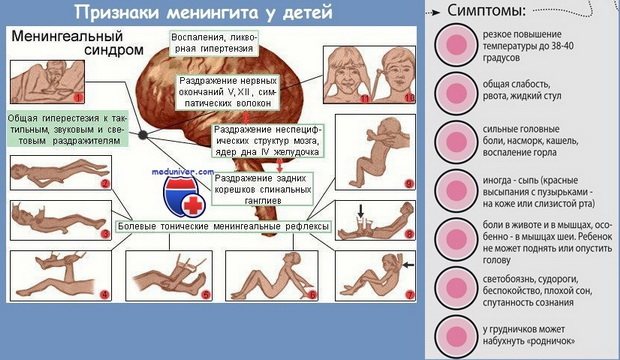
How does meningitis manifest in children over one year of age:
- neck and back are painful;
- drowsiness or, conversely, increased excitability;
- the baby begins to react inadequately to the usual environment;
- heat;
- loss of appetite;
- fainting;
- overly sensitive reactions to light (photophobia);
- nausea and vomiting;
- neck tense;
- purple-red spotty rash.
First signs
The symptoms of meningitis cannot be ignored; they manifest themselves very clearly, causing the patient a lot of suffering. In both adults and children, the symptoms of this disease are almost the same. Later, when meningitis has already progressed, very severe symptoms of a neurological nature may appear, indicating an advanced stage of the pathological process.
Initial signs in children:
- Unbearable headache.
- Severe nausea and vomiting.
- Painful sensations in the eyes, aggravated by pressure.
- Convexity of the fontanel.
- Increased body temperature to high levels.
- Posture characteristic of meningitis - the head is thrown back, and the legs are bent at the knees and pressed to the chest.
- Rash and skin hyperesthesia, the child cannot tolerate any touching of his skin.
- The baby wants peace and quiet; bright lights and any sounds irritate him.
Causes
reasons for the occurrence of meningitis . Most often, this disease occurs against the background of human infection with meningococcal infection. Bacteria enter the body by airborne droplets and penetrate the blood very quickly, causing an inflammatory process in the membranes of the brain.
In addition, the infection can be caused by other viral . Sometimes meningitis can be transmitted in other ways.
Other ways of transmitting meningitis:
- During childbirth, the infection can be transmitted from mother to child.
- When infected feces enter the oral cavity.
- Lymphogenous and hematogenous route.
- Through insect bites.
- Through water contaminated with rodents and food contaminated with meningitis bacteria.
Outbreaks of this disease always occur in spring . The fact is that the body of any person is equipped with an immune system that protects the human body. In spring, the body is very weak, because at this time there is a lack of vitamins, sun exposure, and viruses attack especially actively. Therefore, meningitis bacteria, entering the human body, do not feel obstacles and penetrate the brain.
There are no age restrictions for this disease; cases of meningitis have been recorded in infants 1 month old and in elderly people over 80 years old .
During an epidemic of viruses, especially influenza, you need to constantly strengthen your immune system.
There is another way for meningitis cells to enter the human body; with various skull injuries, bacteria can easily reach the brain.
Diseases that cause meningitis:
- Viral diseases.
- Sinusitis.
- Otitis acute and chronic.
- Furunculosis in the face and neck area.
- Frontit.
- Lung abscess.
- Defeat by osteomyelitis.
It is necessary promptly treat all inflammatory and viral diseases. Therapy should be carried out only under the supervision of a physician, so as not to blur the clinical picture. With self-treatment, any disease can become latent and cause meningitis.
Meningitis in children: symptoms and treatment, prevention, photo
Features of the manifestation of meningitis in children are due to the development of inflammatory reactions in the three-layer membrane of the brain and spinal cord.
The disease affects adults and children, mostly boys. The pathology most often occurs in children with weakened immune systems under the age of 7 years and occurs in a very severe form.
Meningitis in a child can be a consequence of bacterial, viral and fungal infections. Manifest as a primary infection, as an independent disease, or as a consequence of background infectious pathologies. Airborne and contact forms of transmission of infection are typical. This explains the epidemiological nature of the manifestation of meningitis in kindergartens, schools or educational institutions.
The main forms of meningitis in children

There are several main forms of meningitis in children. Their type depends on the specific pathogen that led to the development of the disease.
1) Purulent meningitis in children (pneumococcal form) is caused by pneumococci. It may appear after previous pneumonia or acute ENT pathologies (sinusitis, otitis, etc.).
But in more than half of those affected, this form of the disease can manifest itself independently, without any underlying causes. It is characterized by rapid development and acute course, but characteristic meningeal signs appear no earlier than three days after infection.
Inflammatory reactions spread to the structure of the medulla and involve the ventricular cavities of the brain. During puncture, a large amount of pus, an increased percentage of pneumococci and white blood cells (leukocytosis) are found in the cerebrospinal fluid.
With rapid progression, fainting occurs and partial nerve paresis develops. This form of the disease is considered the most dangerous.
2) The hemophilic form is provoked by the Pfeiffer bacillus (hemophilus). This pathology most often develops in infants under one year of age, but also occurs at older ages. It may manifest itself immediately as meningeal signs, or catarrhal symptoms similar to acute respiratory infections (runny nose, sore throat, cough), and symptoms of the disease itself appear on the fourth or fifth day.
Particular attention should be paid to the malaise of young children. Signs of meningitis in infants can manifest themselves as excessive swelling and lack of pulsation of the fontanel, frequent regurgitation, vomiting and causeless screaming.
In such a situation, the child should be immediately taken to the hospital or an ambulance should be called.
3) The manifestation of viral meningitis is caused by exposure to various infectious virus virions. It is characterized by a gradual development - first, a viral pathology develops, with all the characteristic signs, followed by the manifestation of meningeal syndrome. With severe severe headaches and a depressed general condition of the baby, the syndrome itself manifests itself weakly and not always in full.
Loss of consciousness, as with other forms of the disease, practically does not occur. Blood parameters, when analyzed, are more similar to viral pathology tests. But, if you do not start timely treatment, after some time, they will manifest themselves in full.
4) Meningitis of the tuberculous form is rare today and poses a great danger to children. Until recently, the mortality rate among children was very high. The disease is characterized by an atypical course, which complicates timely diagnosis and treatment. The most vulnerable are young children (from 2 to 5 years old)
The acute onset and rapid growth of meningeal syndrome is explained by the low resistance of the unformed child’s body, against the background of the rapid passage of various harmful substances through the blood into the brain tissue and cerebrospinal fluid.
Localization of pain symptoms in the occipital and frontal zone, constant profuse gag reflex, independent of nutrition, require immediate diagnosis.
In newborn babies, meningeal syndrome is a consequence of congenital infection (herpetic or toxoplasma infection).
The bacterium Neisseria meningitidis (meningococcus) is dangerous for one-year-old children. And for younger schoolchildren, pustular infections caused by staphylococcus and streptococcus pose a danger, creating the preconditions for the development of the disease.
- The risk of developing tuberculous meningitis in adolescents is very high.
A high incidence rate is observed in the age group of children under six years of age. Meningitis is characterized by seasonality (winter-spring) and a certain cyclicity - every ten years. The viral form of the disease is more easily transmitted than other types.
The greatest likelihood of developing fatal complications is observed in bacterial and purulent forms of the disease. Therefore, you should not waste a minute when identifying meningeal signs in a child.
The first signs of meningitis in a child, photo
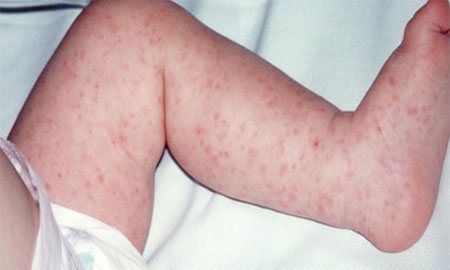
appearance of a characteristic rash, photo
The first signs of meningitis in children are manifested by characteristic symptoms of infectious diseases - weakness, very high fever, loss of appetite, alternating chills and fever. So, there is nothing strange in the fact that parents often treat such manifestations as a common cold infection.
Only the further appearance of specific signs, which, regardless of the underlying cause, are almost always the same in children, can indicate pathology. Wherein:
- A pronounced red-violet or yellow hemorrhagic rash in the form of spots spreads throughout the body. The combination of rashes with signs of an infectious disease indicates the development of meningococcemia - infection in the blood (dangerous blood poisoning).
- The body temperature exceeds forty degrees and no antipyretics can reduce it.
- There is overexcitation, or depression, lethargy, drowsiness and uncontrollable crying.
- Frequent vomiting, which does not depend on what you eat, does not bring relief.
- Characterized by an acute painful reaction to light, sounds, and even light touch to the skin.
Features of meningeal symptoms
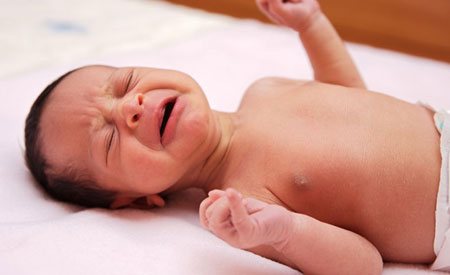
Any form of the disease has the so-called triad of common symptoms of meningitis, characterized by:
- Severe intense pain in the head of unknown localization, caused by swelling of the meninges, causing compression and irritation of the nerve fibers. Soreness develops almost instantly, at the beginning of the disease. When pressing on areas close to the surface of the nerve endings (the center of the forehead, the base of the wing of the nose, the area of the nasolabial triangle), the pain intensifies.
- Signs of intoxication (nausea and vomiting) caused by swelling in the membranes of the brain, leading to irritation and disruption of electrical stimulation of the vomiting center. Vomiting does not cause relief, as with gastrointestinal infections.
- Very high temperatures, as a result of intoxication, at the very beginning of the disease. The fever can last up to four days, even if adequate therapy is provided. The action of the pathogen's toxins inhibits the body's functions, causing lethargy, apathy towards food, and muscle weakness in the baby.
The main symptoms of meningitis in children
The main symptoms of meningitis in children include the so-called meningeal symptoms, caused by irritation of the nerve tissue in the meninges. Their manifestation is characterized by:
- A sharp increase in muscle tone in the occipital part of the head. As a result of their constant tension, it becomes impossible to press the chin to the chest.
- Rigidity of the biceps femoris muscle. Increased muscle tone does not allow a child lying on his back to raise his legs up so that an angle of 90 degrees is obtained in relation to the torso.
- A characteristic cervical syndrome is the simultaneous pressing of the thumb and index finger on the cheeks in the area under the cheekbone, causing the patient to involuntarily raise his shoulders.
- Tripod pose – spasmed spinal muscles do not allow one to sit normally. This is only possible with support from your lowered hands.
- A pose typical of a pointing dog (cocked hammer) - a position in which you can only lie on your side, pulling in your stomach, pressing your legs to it and throwing your head back.
- Hanging test (Lessage's sign). Suitable for relatively young children. If the baby is held vertically by his armpits, he will involuntarily pull his legs towards his stomach.
Diagnosis confirmation
Diagnostic methods are aimed at identifying the root cause of the disease - a specific pathogen. To do this:
- general examination and biological blood tests;
- bacteriological analysis of cerebrospinal fluid (smear) through lumbar puncture;
- a culture of nasopharyngeal mucus is done;
- PRC examination.
Only after the cause has been reliably identified, a treatment protocol is drawn up.
Treatment of meningitis in children
The course of therapeutic treatment for meningitis in children usually lasts from one to one and a half weeks. In the presence of infections, special supportive therapy is prescribed, aimed at restoring and correcting impaired functions in the body. As a rule, cerebrospinal fluid levels return to normal on their own within a week.
If the condition improves, a repeat lumbar puncture is performed two weeks later; if there is no improvement, a repeat sampling is carried out two days after the first puncture and changes are made to the treatment regimen. After recovery, dispensary monitoring is carried out throughout the next year.
It happens that despite all the obvious meningeal symptoms, laboratory tests do not reveal changes in the cerebrospinal fluid; in such a pathological condition, meningism is diagnosed. This is due to the large quantitative volume of cerebrospinal fluid formed as a result of intoxication.
In this situation, the infection cannot overcome the blood-brain defense (barrier) and is not able to penetrate the brain. Correction of the condition is carried out with detoxification therapy.
With timely detection and proper treatment of meningitis, the symptoms go away and no damage to internal systems and organs is noted. Only for a long time after meningitis can a child experience:
- signs of aggression and irritability;
- hysterics and insomnia;
- inattention and difficulties in mastering the school curriculum.
The right approach to the problem will help eliminate everything over time.
Prevention rules
The main rule of prevention is vaccination against colds. The meningitis vaccine itself cannot completely protect against the disease, but only reduces the risk of infection. Since there are many forms of the disease, you can only protect yourself from them by strengthening your immune system.
- It is necessary to expand the baby’s diet with fresh, natural products;
- In the form of vitamin therapy, add more fruits and vegetables to your diet;
- Take your child out into nature more often to get some fresh air;
- Teach personal hygiene;
- Keep your child’s room clean, monitor the temperature and humidity levels, and ventilate the room more often.
I tried to talk in simple language about the main symptoms, treatment and prevention of meningitis - the first signs of the disease and the characteristic triad should help early diagnosis and timely seeking medical help. Be healthy!
It should be noted that meningitis in adults differs from the “childhood” form of the disease.
Does the rash with meningitis itch?
A skin rash can be a manifestation of any disease. How to determine what is the cause of the rash? The peculiarity of meningitis rashes is that they do not itch or hurt. At the initial stage, small scatterings of red pimples can be observed, later they grow , occupying an increasingly larger area, increasing in size.
Diseases manifested by skin rash:
- Chicken pox.
- Rubella.
- Scabies.
- Measles.
- Mononucleosis.
- Allergy.
If the skin rash is accompanied by a high fever and severe headache, you should go to the hospital immediately. This state means that life is counted by the clock.
Treatment of meningitis
The mainstay of treatment for meningitis is antibiotics . With the help of these drugs, it is possible to stop the development of the disease. Therapy is carried out exclusively in the infectious diseases department of the hospital.
First of all:
- The patient is provided with bed rest and gentle nutrition, as these are important conditions that must be observed for the treatment to be effective.
- In addition to antibacterial agents, the treatment of meningitis includes antiviral drugs, and, if necessary, resuscitation measures are performed.
- Antihistamines and anti-inflammatory drugs are prescribed to alleviate the patient's condition and relieve symptoms.
The course of treatment for a person of any age with meningitis is 10 days . If there are complications in the form of pus in the cranial cavity, then the treatment time increases. After discharge from the hospital, the patient remains on home treatment for a long time. Some people who have had meningitis need about a year to fully recover.


